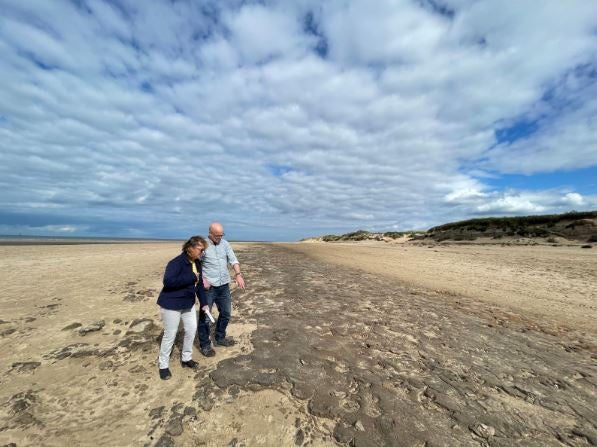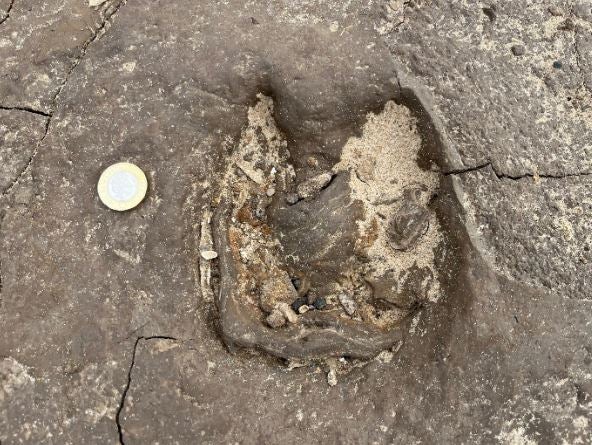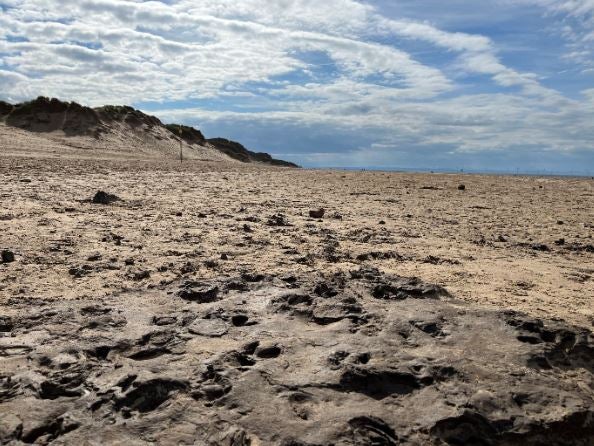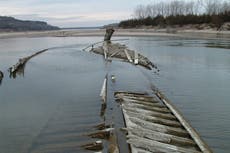How scientists are taking ‘snapshots’ of prehistoric Britain
New research reveals details of the lives of Britons who lived up to 8,500 years ago
Scientists have been using sophisticated forensic techniques to create snapshots of life in prehistoric Britain.
By discovering, recording and analysing ancient footprints, they have been able to reconstruct in considerable detail specific moments in the lives of Britons who lived up to 8,500 years ago.
The research has been carried out on a beach near Formby, 12 miles north of Liverpool.
Hidden several metres below the surface of the region’s intertidal zones are tens of thousands of human and animal footprints left on long-buried mudflat surfaces. So rich was the ecosystem revealed that scientists believe the area was “like a prehistoric British Serengeti”.
Thousands of years ago, the sun “baked” those footprints and hoofprints hard in the hours after they were made, preserving their shapes before they were rapidly covered by a thin layer of sand by the next incoming tide.
Now a reverse process has been occurring, with storms and some tides uncovering, eroding and then re-burying the prints. It’s estimated that, over the past two and a half decades, around 5,000 such prints have been briefly exposed before being broken up by wave action or reburied under sand.
But during the time that the prints have been exposed in a fully intact and visible state, scientists from the University of Manchester have been busy recording them.

Their ongoing research is revealing previously unknown data about the lives and times of the people who inhabited Britain’s coastal regions before, during and after the introduction of agriculture.
The oldest series of footprints, from 8,500 years ago, are those of a lone adult man who might have been stalking a large water bird, a crane, some of whose footprints are immediately adjacent to the human ones.
The footprint evidence suggests that, as part of his possible stalking operation, this man walked very slowly and paused for a moment, perhaps in order not to alarm the bird. Cranes would have been a good source of meat and their spectacular feathers might also have been highly prized. Certainly, in many ancient cultures, crane feathers were used in ritual head-dresses.
Another moment in time, recorded by other footprints at the site, show two toddlers, each around two years of age, and five older children – aged seven to nine – almost certainly accompanied by an adult woman, probably their mother.
One day, probably a morning, in early summer around 8,100 years ago they were walking as the tide was going out across a section of the mudflats that seems to have been crowded with herds of red and roe deer and giant wild cattle.
Interestingly, the cattle – dozens of whose hoof prints have survived – seem to have been particularly attracted to the wettest and muddiest parts of the mudflats. This is possibly because these areas offered them an opportunity to wallow in the mud, a specific known behaviour used by some types of cattle to rid themselves of ticks and tick larvae.

The footprint record also shows that there were other humans walking across the mudflats on the same morning as the mother and her seven youngsters were there. Those other people included a very tall lone adult male and four unaccompanied older children, aged between 10 and 14.
But prowling around on the mudflats that same morning was a lone wolf, who was no doubt looking for an animal or young human victim to kill and devour.
The presence of older children on the mudflats is particularly interesting. Children are usually virtually invisible archaeologically, but the new footprint evidence reveals that dozens of such unaccompanied Mesolithic children were operating both economically and socially on the mudflats. Their roles seem to have been to take care of younger children and almost certainly to gather shellfish or attend to fish traps.
On another early summer day around 5,300 years ago, the footprint record froze another random moment in time. It reveals a very brief meeting between an adult Neolithic female, her two children and another adult female. The footprint record shows that the first woman and her four and 10-year-old children paused briefly to greet the second woman, who passed them at right angles.

One of the most remarkable new pieces of information to emerge from the footprints research is the apparent height of some of the people. Forensic analysis of footprint data allows scientists to calculate how tall each person was.
Until now, archaeologists had generally assumed that Mesolithic Britons were relatively short, but the footprint research suggests that at least some of these coastal people were actually very tall.
Adult Mesolithic males operating on the mudflats seem to have been around 5ft 8ins tall on average. What’s more, between 40 per cent and 58 per cent of them were between 5ft 9ins and 6ft 4ins tall. The Mesolithic coastal women were also taller than previously thought – between 5ft 3ins and 5ft 5ins.
This unexpectedly tall male – and, to an extent, female – stature might well have been because of the particularly rich nutritional environment they functioned in.
The coastal zone, especially the mudflats, was particularly rich in protein and other food resources.
The mudflats were home to herds of red deer, roe deer and giant wild cattle, aurochsen, as well as many different species of water birds and protein-rich shellfish, including razor clams, whelks and cockles. It’s also likely that local humans used fish traps across narrow tidal channels to catch eels and other fish.
What’s more, it’s likely that, immediately adjacent to the mudflats, they would have had access to highly nutritious meadows of wild samphire – an edible plant that grows on salty soil and is rich in calcium, iron and vitamin A.
The research is also revealing previously unknown differences between the Mesolithic and Neolithic coastal economies.
The vast majority of footprints suggest that during the Mesolithic, around 6,000 years ago, people exploiting the mudflats tended to walk parallel to the seashore rather than walking from the land to the sea.
By contrast, the footprint evidence shows that Neolithic coastal dwellers, operating there after 6,000 years ago, tended to do the opposite.
They mainly used the mudflats as a means of accessing the seashore and virtually all their footprints show them walking from the land to the sea, or vice versa, and hardly ever merely along the foreshore.
So important was it for these Neolithic coastal people to reach the seashore that they actually constructed a wooden trackway nearby to take them across the mudflats to the open sea.
The scientists therefore think that a change of direction in the footprints between the Mesolithic and the Neolithic reflects increasing use of fishing boats by the Neolithic population.
However, the nature of the Neolithic footprints suggests that people were definitely not carrying heavy boats across the mudflats. So, if they were crossing the mud to go fishing, their craft must have been much lighter than the ultra-heavy dugout canoes normally associated with prehistoric Britain.
This new indirect evidence from the footprints therefore suggests they were using lightweight, skin-covered, wooden-frame or basketwork boats similar to modern traditional currachs in Ireland or coracles in Wales.
The newly analysed footprints constitute some of the earliest pieces of evidence of the use of such light craft in prehistoric Britain.
The radiocarbon dates in the new research, published on Monday in the journal Nature Ecology & Evolution, shows that the most species-rich footprint beds at Formby are up to 4,000 years older than previously thought.
“The footprint beds show that, as global sea levels rose rapidly after the last ice age around 9,000 to 6,000 years ago, humans formed part of rich intertidal ecosystems alongside aurochsen, red deer, roe deer, wild boar and beaver, as well as the predators wolf and lynx,” said archaeologist Dr Alison Burns, who spent six years undertaking the field research.
The footprints and hoofprints also reveal how humans came to dominate the environment and how the number of large wild mammal species dramatically declined in this coastal zone.
“Our research shows how, in the Mesolithic period, the prehistoric mudflats area near Formby was a biodiversity hotspot with large grazers and predators – a northwest European Serengeti,” said Professor Jamie Woodward, who is a co-author of the study.
“The observed decline in large mammals in the footprint record could be the result of several drivers, including habitat shrinkage, following sea-level rise and the development of agricultural economies, as well as hunting pressures from a growing human population,” Dr Burns explained.
“The Formby footprint beds form one of the world’s largest known concentrations of prehistoric footprint and hoofprint tracks. This is the first time that a faunal history and ancient ecosystem has been reconstructed solely from foot and hoof print evidence,” said Dr Burns.
“Assessing the threats to habitat and biodiversity posed by rising sea levels is a key research priority for our times – we need to better understand these processes in both the past and the present,” added Professor Woodward.
“This research shows how sea-level rise can transform coastal landscapes and degrade important ecosystems.”
Join our commenting forum
Join thought-provoking conversations, follow other Independent readers and see their replies
Comments


Bookmark popover
Removed from bookmarks